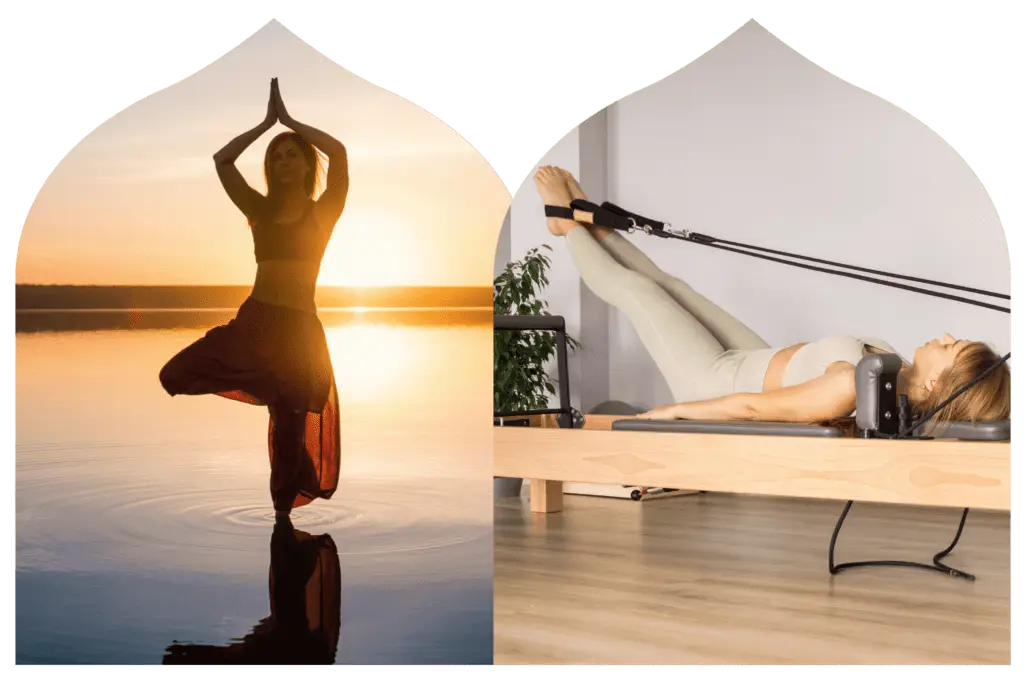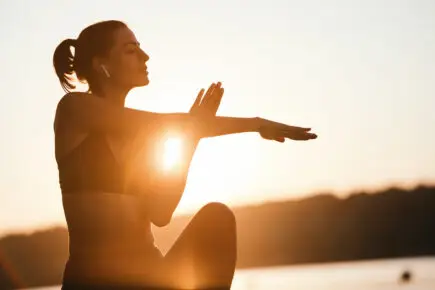
Very good! We welcome you to the Quiroesencia blog. Today we are going to discuss the differences between Yoga and Pilates, two widely practiced disciplines that have aspects in common, although of course, they also differ in others. Here I want to present the difference between both practices so that my potential students know the benefits that each one has.
A quite…different… introduction to each discipline
The way I was introduced to yoga and Pilates could have had an impact on my choice to study yoga in depth. I discovered yoga for the first time when I was 17 years old in a gym, next to my mother. I felt very grown up the day she took me to the gym with her and I tried the yoga class she went to weekly with her teacher, Inara.
I remember images of trees, forests, birdsong (which I may have had as background sound or within the music). There was a dim light, and at the end of the class, in Savasana (final relaxation) and in a very short meditation afterwards, feeling a tranquility that I did not know when I was 17 years old.
Pilates, however, I tried at a fairly basic gym I attended when I was 24 years old. In the Pilates class we did many postures similar to yoga, but without visualization, concentrating on breathing and activating the abdominal muscles.
I remember that it was a good physical challenge, but I felt tremendous boredom. I looked at the clock all the time and the electronic music that the teacher played was so quiet that it was more of a distraction than a good accompaniment–it neither encouraged me nor entertained me. The teacher didn't put much effort into the class, she was probably poorly paid and although there are excellent teachers in some gyms, this was not an example of that.
Clearly, you have to have a good introduction to any discipline or activity to understand it well, and it is many years later, now 41 years old, that I really understand the benefits of Pilates. I still support yoga for its spirituality, but now we will explain the differences and what yoga and Pilates have in common.
Some scientific studies on the benefits
It is interesting to see that yoga and Pilates are well studied in their benefits for the body and the nervous system.
For example, this 2015 study from the US National Institutes of Health showed that yoga practitioners over time increased the amount of “gray material” in their brains and also the volume of other parts of the brain.
Pilates has also been seen in scientific research, but most studies show its effect on physiology and less on well-being, mental balance, etc.
In a 2020 study, which results from a collaboration between researchers at the University of Jaén and the University of Cádiz, it is explained how the practice of Pilates benefits older people in their cognition and functional skills. (verbal and brain executive functioning skills, and flexibility and strength in the legs and trunk).
What our students who combine the two practices say
I see that among my students at our yoga and massage center, Quiroesencia, there are some who also practice Pilates and are delighted with how the two practices complement each other.
There are others who come into the room and discover that they are not interested or ready to enter into a spiritual practice, which I can respect and understand.
However, there are others who stay with a more physical and less spiritual practice, and when they arrive at the room without knowing that a more meditative practice of self-knowledge, mindfulness and self-compassion existed, they stay with me for years.
Which to choose?
There are many today who seek physical activities that improve health and well-being at the same time and that can be understood with the fast-paced life that we live more and more every day.
Yoga and Pilates emerge as the first two options for many people since they offer strengthening, stretching, and being very aware of the body from one moment to the next.
Often faced with the question: Which one to choose? It is essential to understand the differences between yoga and Pilates, as well as their unique benefits in order to make an informed decision about which may be best suited for oneself.
Additionally, consider combining yoga and Pilates classes with other forms of exercise, such as strength training, cardio or outdoor activities, to obtain a holistic approach to physical well-being and reap the full benefits of lower stress.
Main differences between Yoga and Pilates.
Although Yoga and Pilates share some basic principles, such as a focus on breathing and the mind-body connection, there are also significant differences between the two practices.
Knowing these differences can help determine which modality is best suited for your specific needs and goals.
Philosophy and spirituality
Deeply rooted in a rich spiritual tradition, Yoga seeks the union of body, mind and spirit. Through the practice of asanas, pranayama and meditation, yoga aims to achieve a state of harmony and balance in all aspects of life.
Although Joseph Pilates incorporated some principles of Eastern philosophy into his method, such as the importance of breathing and concentration, Pilates focuses mainly on physical strengthening and rehabilitation. Spirituality is not a central component of Pilates practice.
Exercise Focus
The practice of yoga focuses on fluid movement through a series of postures designed to strengthen, stretch and balance the body. Postures are held for varying periods of time, and attention is directed toward body alignment and conscious breathing.
The exercises of Pilates are designed to strengthen muscles central parts of the body, including the abdominal, lumbar and gluteal muscles. Movements are typically more controlled and precise, with an emphasis on spinal alignment and stabilization.
Equipment used
Traditionally, yoga is practiced without the need for equipment, using only body weight and a mat. However, in some more modern forms of yoga, such as aerial yoga or prop yoga, additional devices may be used to facilitate certain poses.
Although Pilates exercises can be performed on a mat, many Pilates classes use specific equipment designed by Joseph Pilates, such as the reformer, the Cadillac and the barrel.
These equipment provide additional resistance and support to improve the effectiveness of the exercises.
Breathing
The breathing plays a fundamental role in the practice of yoga, with emphasis on deep, conscious breathing that accompanies each movement. Yogis often coordinate breathing with movement, using inhalation and exhalation to ease the transition between postures.
There are many different breathing techniques in yoga, with a lot of variation between them depending on what the yogi or yogini wants to achieve – raise the energy in the body, relax the mind, etc.
In our yoga classes, in addition to other breathing techniques, we always work with Ujjayi Pranayama, which is a way to focus the mind and strengthen the will in maintaining the postures.
While breathing is important in Pilates, the approach is slightly different. In Pilates, a lateral breathing, where you inhale through the nose and exhale through the mouth, keeping the abdomen contracted to maintain central stability during the movements.
Flexibility vs. Force
While yoga can help build muscle strength, Their main focus is usually on flexibility and stretching. Yoga postures are designed to increase range of motion in the joints and improve muscle elasticity.
Pilates focuses on developing core strength and stability, with a particular emphasis on the abdominal and lumbar muscles.
While flexibility is also an important component in Pilates, the main goal is to strengthen the deep muscles of the body to improve posture and prevent injuries.
Variety of styles
exist numerous styles and approaches of yoga, ranging from gentle and restorative, such as Yin Yoga and Restorative Yoga, to vigorous and dynamic, such as Ashtanga and Vinyasa yoga.
There are also more esoteric styles such as Kriya Yoga and Kundalini Yoga, or more modern styles such as Power Yoga, which already leaves the traditional and spiritual line.
Each style offers unique benefits and can be tailored to individual needs and preferences.
While there are variations to Pilates practice, such as Classic Pilates and Contemporary Pilates, the basic method remains. quite consistent in its approach in core strength and stabilization.
The differences between Pilates styles are often more subtle compared to yoga.
This is how both disciplines complement each other
When exploring the differences between yoga and pilates, it is also important to recognize that these two practices can complement each other to provide a wider range of benefits to health.
Integrating both yoga and Pilates into an exercise routine can provide a unique combination of strength, flexibility, balance, and mental well-being.
Some additional benefits include:
- Comprehensive strengthening: While pilates focuses on strengthening the core muscles and stabilizing the spine, yoga can target different muscle groups and promote more balanced muscle development throughout the body.
- Improved Flexibility: Yoga is known for its ability to improve flexibility in a very profound way and even work on a somatic level with stored emotions. Yoga also improves range of motion in the joints, while Pilates can help develop functional flexibility that improves movement efficiency and reduces the risk of injury.
- Postural correction: Both yoga and pilates can help improve posture by strengthening core muscles and promoting proper body alignment. In yoga, the posture is worked on in movement by flowing from one posture to the next, while in pilates the posture is worked on the movement within each position, that is, with a very specific and limited range of movement. Therefore, combining both practices can address different aspects of posture, from core stability to spinal alignment.
- Stress reduction: Both practices have a focus on conscious breathing and relaxation, which can help reduce stress, anxiety, and muscle tension.
Yoga also provides a spiritual and ritual touch, which can add to the experience of relaxation and connection that a practitioner feels.
The effort required to practice pilates (and yoga in its more dynamic forms) causes the production of chemicals in the body that induce relaxation and stress reduction, in addition to releasing stress from the muscles themselves.
Integrating yoga and Pilates into an exercise routine can provide an effective outlet for stress and promote relaxation to improve emotional well-being.
The practice of yoga focuses on body awareness and develops concentration when breathing while doing the postures, due to the need to focus on doing balance postures, and when practicing with a purpose beyond improving the aesthetics of the body.
The practice of mindfulness also helps in developing awareness, which carries over into everyday life. Incorporating elements of yoga into your Pilates practice can also improve the mind-body connection and body awareness.
Considerations when choosing
When considering which of these practices might be most suitable, it is important to take into account factors such as current physical condition, personal preferences, and exercise goals.
Here are some key considerations:
- Injuries and medical conditions: those with specific injuries or medical conditions may benefit from one practice over the other. For example, Pilates may be more suitable for rehabilitation of muscle injuries, while yoga may be beneficial for those who carry a lot of tension in their body and need to reduce stress, or if they play sports and need to improve their flexibility.
- Personal preferences: Some people may be more drawn to the spiritual aspect of yoga, while others may prefer the more physical and disciplined approach of Pilates.
- Exercise goals: Those looking to strengthen the core and improve postural stability may find Pilates more suitable, while those who want to improve flexibility, balance, and reduce stress may prefer yoga.
Incorporating yoga and Pilates into your exercise routine
We would like to emphasize that since there are differences between yoga and Pilates, the combination of both disciplines provides important benefits, since both practices can complement each other and form part of a balanced exercise routine.
Many people choose to alternate between yoga and Pilates classes to gain a variety of physical and mental health benefits, including changing depending on the season or the stresses and needs in their life.
We know that life is cyclical, just like the seasons, and at Quiroesencia, our wellness center, we always put a focus on the needs of the individual that day and in that season of their life.
When exploring these practices, it is important to try different styles and classes to find what best suits individual needs and preferences.
Whether you choose yoga, pilates, or both, the most important thing is to find a practice that inspires you, challenges you, and helps you achieve your physical and mental wellness goals.
If you want to know more about our group and individual classes, as well as massage and osteopathy sessions, I invite you to contact us.
Citations:
- Neuroprotective effects of yoga practice: age-, experience-, and frequency-dependent plasticity
- Chantal Villemure, Marta Čeko, Valerie A. Cotton, and M. Catherine Bushnell.
- Grady, JS, Her, M., Moreno, G., Perez, C., & Yelinek, J. (2019). Emotions in storybooks: A comparison of storybooks that represent ethnic and racial groups in the United States. Psychology of Popular Media Culture, 8(3), 207–217. https://doi.org/10.1037/ppm0000185



